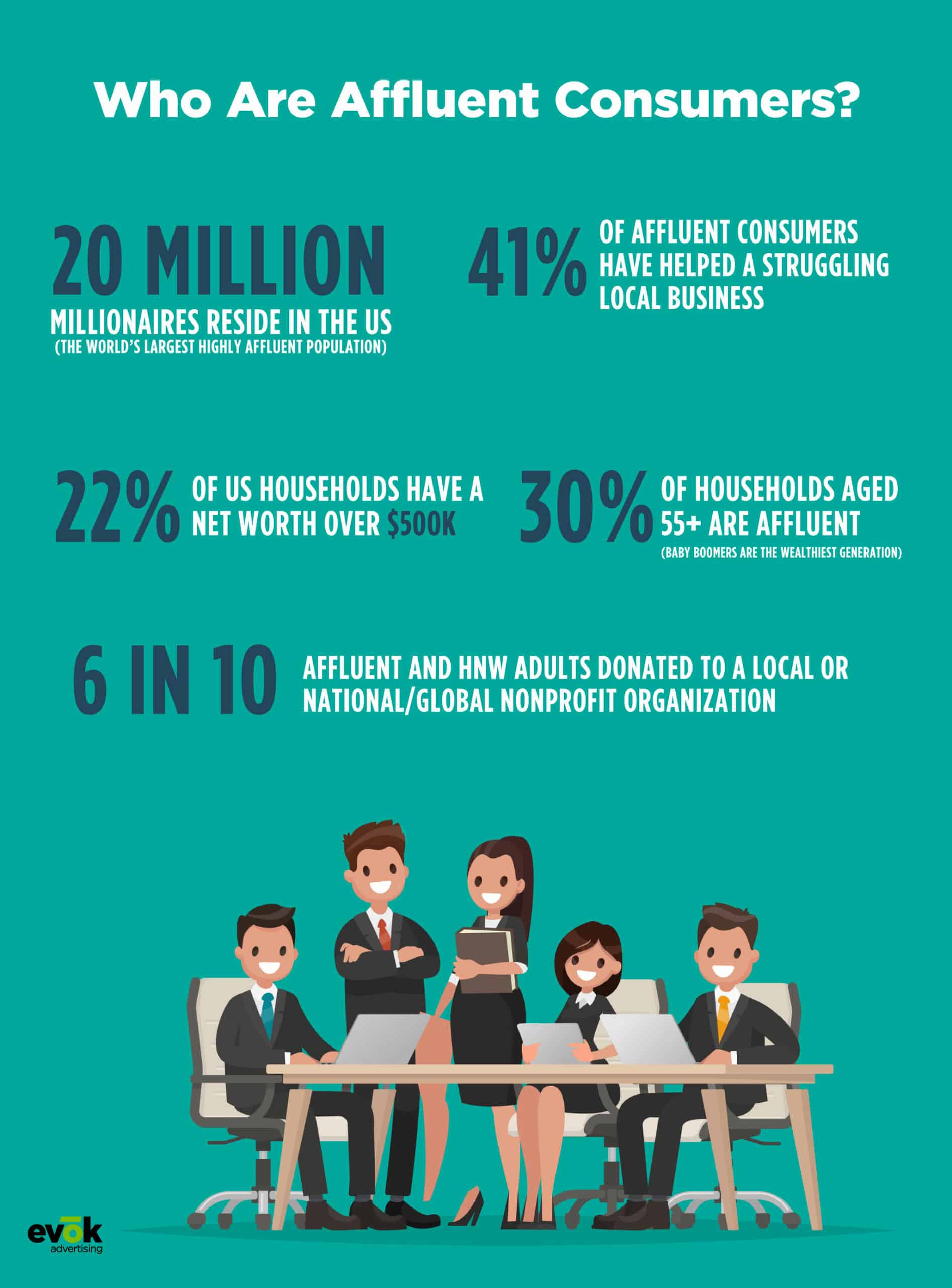
Targeting the Affluent Consumer as a CPG Brand: Lifestyle Marketing
From $1,500 phones to designer athleisure, consumption of consumer goods is nearing all-time highs. People are on never-ending searches for the next best luxury product, chasing a lifestyle of comfort and class. But winning the affections of the affluent market isn’t exclusively for luxury brands and goods. High-net-worth individuals and households falling into the category of affluent consumers have complex identities and demand a variety of products and services, willing to pay a premium for those that align with their lifestyle.

A Look into the Affluent Consumer: Who They Are and What They Value
Consumer Net Worth, Age and Location Data
The most recent data available from the US Census Bureau estimates that 28.63 million households, or about 22% of all households, in the US have a net worth of $500,000+. The US has far more millionaires than any other country – its 20.27 million adults represent about 40% of the world’s millionaire population. The US also leads the world with its number of ultra-high net worth adults. At the midpoint of 2020, there were an estimated 89,630 ultra-high net worth individuals in the US whose net worth exceeded $50 million.
At least 30% of householders aged 55+ are affluent or high net worth, making Baby Boomers the wealthiest generation. Millennials and Gen Z adults, however, are more likely to be saddled with student debt and other financial obligations, including paid childcare, and they are less likely to have acquired much wealth at this point in their lives. In fact, 30% of householders under the age of 35 have either no net worth or owe more money than they have
Target Audience and Consumer Moral Values
Nearly all adults agree that now — during the COVID pandemic — is the time for those who are able to donate to good causes and support struggling businesses to make an effort to do so. Amongst the affluent population, agreement with this sentiment is significantly higher.
Many wealthier adults feel an obligation to use their means to better society. Charitable donations and showing their support to struggling businesses are both ways that wealthy individuals fulfill this responsibility.
Consumer Spending Habits and Economic Impact
Aside from apparel, relatively few affluent and high-net-worth adults made purchases on items such as beauty products, fashion accessories or home décor in the past six months. Compared to the general population, however, wealthier adults appear more willing to pay for landscaping and housecleaning services.
Affluent consumers are also typically more investment focused. Most are homeowners and, therefore, money spent on improving the home could potentially increase the market value of their home later
Marketing to Affluent Consumers: What CPG Brands Need to Know

Audience Demographics: Narrow Down Your Audience
First things first, it’s important to understand the benefits of narrowing down your marketing approach to specifically target affluent consumers. For CPG brands whose product offerings align with the values and spending habits of this higher-net-worth population, catering to these premium shoppers looking for quality over price proves a more effective strategy to yield results you can see in your annual sales and profits.
As both marketers and consumers, all of us are aware of the power of connecting brands to consumers. There’s the grocery store you’ll drive out of your way for out of (perhaps unconscious) brand loyalty or the Peloton you purchased to be part of the tight-knit community it fosters. Niche messaging and lifestyle-focused targeting works to form those connections, and narrowing down who your brand speaks to is the only way to ensure a bond deep enough to inspire trial and loyalty.
Future Marketing Efforts When Considering the “Next Normal”
While the COVID pandemic’s effect on affluent households was not nearly as severe as for those with lower net worths, there were a number of shifts in their behaviors and spending patterns. Increases in paid services like grocery and food delivery and decreases in household spending were marked, however brands and businesses should look to affluent and high-net-worth consumers to be among the first to return to their pre-pandemic spending habits. Our agency’s research partner, Mintel, reports affluent and high-net-worth individuals expect to resume paying for services like house cleaning and landscaping post-pandemic. Data from May 2020 also suggests these individuals are eager to travel domestically and invest in home renovations and improvements.
Companies determining their post-pandemic strategies could find opportunities targeting the top 20% of households with premium products and services. Becoming part of these consumers’ “next normal” could build long-term loyalty as their incomes and wealth continue to grow.
Moral & Societal Values-Based Marketing
Affluent adults are willing to contribute financially to causes that help the people in their immediate communities. Many are business owners themselves or are at least familiar with the fundamentals of running a business, and they are aware of the challenges that small local businesses have faced during the pandemic.
Wealthy consumers are willing to support the people and businesses in their local communities, making a strong case for premium brands to partner with these causes. CPG brands may consider working with nonprofit organizations, whether they are local or national, and focus on personal stories in marketing content. Helping donors envision who and how their money is helping can make their donation feel more personal.
Traditional Media Strategies Still Win
As a result of affluent consumers skewing older than the general population, their media habits lean toward more traditional forms of media and away from digital news and entertainment options. Few affluent consumers have “cut the cord.” They are significantly more likely than the average adult to watch broadcast or paid television networks. They are also more likely to rely on print media including magazines and newspapers for information. Adults in this group under the age of 55 are more engaged with social media and streaming services, but these consumers represent a very small share of the market.
Campaigns aimed at reaching affluent consumers should prioritize television advertising. Three quarters of these adults watch live television, making TV commercials an ideal way to reach them. Ad buys during sports and news content are especially effective as live viewership is highest during these types of programming.
Of note, while wealthier adults are significantly less likely to consume digital media such as streaming video or music, 61% listen to satellite or traditional radio. As a result, for brands trying to reach this audience, it could be worth investing in a media plan that includes radio airtime in addition to television. Podcast sponsorships and ads on streaming media platforms are unlikely to reach this target audience.
CPG Marketing Based on Price and Perceived Value
How do the wealthy stay wealthy? The answer may not be straightforward — or our world would look vastly different — however, one factor remains consistent. Affluent individuals are not interested in making frivolous financial decisions and value is still a major driver for them. That being said, definitions of value may differ.
Wealthier customers have the means to buy high-quality items and are willing to pay more for products that will last. For them, value stems from longevity, and it is worth investing in purchases that will not need to be repeatedly replaced.
Affluent and high-net-worth adults can afford most things, so they have more options available to them. While finding the lowest price for an item isn’t a top priority for wealthy consumers, they still do not wish to pay more for an item than necessary. As a result, they are more willing than the general population to purchase more of something to get a better price. If these consumers can afford to spend more now to save more in the long run, more than half will do it.
To become a successful lifestyle brand, one that caters to the wants and needs of an audience beyond the superficial, CPG marketers must pay special attention to those whose business they want to win. This requires digging deep into the demographics and psychographics of consumers, in this case those in the affluent category, and demonstrating how your brand fits into their day to day.